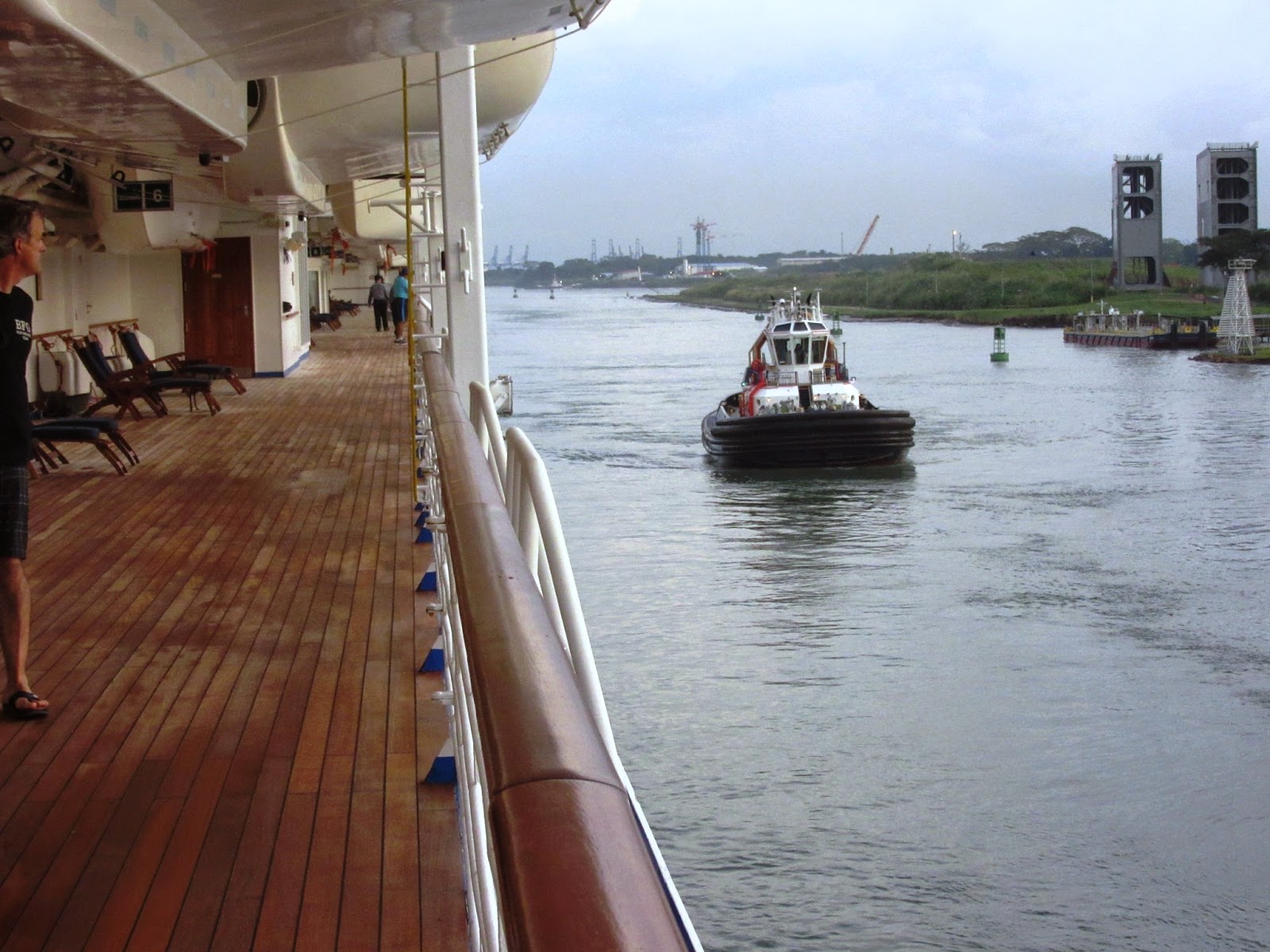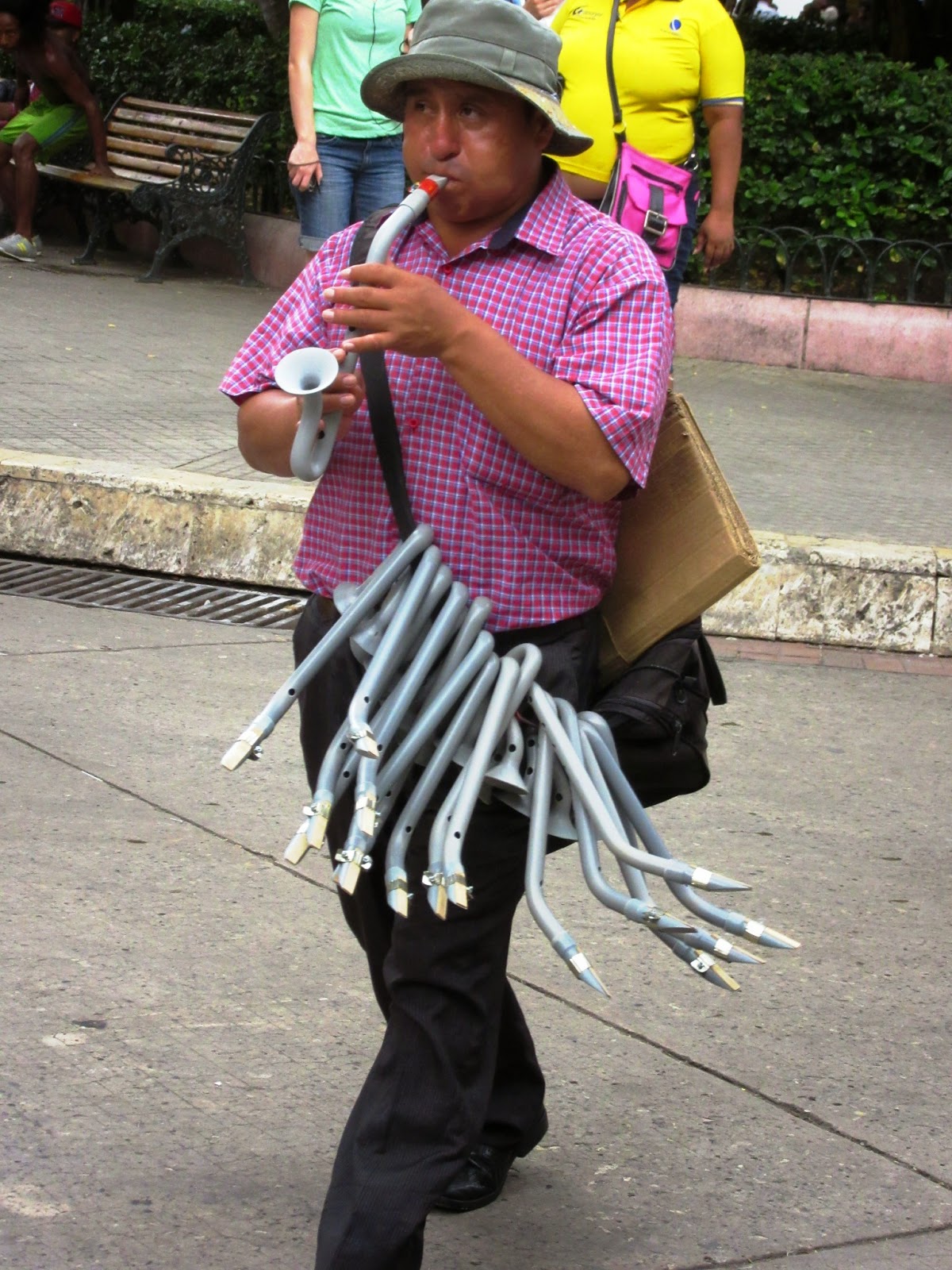 |
| Celebrating 100 Years of operation at the Panama Canal |
Our cruise ship slowly and carefully entered the approach-way
to the Panama Canal around 6:00 this morning, December 7th
2014. Yes, it was Pearl Harbor Day+73,
but the excitement of nearing the canal superseded any immediate recognition on
our part of this historic date. We
scurried around the decks of the Coral Princess looking for an optimal
viewpoint, while garnering the ambiance of a strange and different land.
 |
| Our ship being accompanied into the Panama Canal |
We were floating thru a narrow channel past a
shoreline dense with jungle, as we cruised ever closer to the famous Panama
locks; the climate had become hotter and more humid which was indicative of our
proximity to the equator. But even these
were not distractions to our immediate awe of cruising toward the Panama
Canal. We tried to assimilate our new
surroundings as best we could from the promenade deck of the ship, but then we
positioned ourselves directly above the ship’s bow where we could see
everything in front of us and get the best pictures.
 |
| Approaching the Gatun Locks |
The ship’s public address system kept us continually
apprised of activity thru the canal, announcing every movement of the ship. Finally, we got within sight of the locks,
and the ship lined herself up with the lock on the left side.
There are 2 sets of locks here on the Caribbean
side, which allows 2 sets of ships to go thru the Panama Canal at the same
time. The Panamanians love as much
traffic as they can accommodate; the more traffic, the more money they collect
for allowing these ships to cut thru their country. And, we’re talking $8 to $10 million dollars
per day for Panama! More on that later.
 |
| The mule on the right positions itself to guide the Coral Princess through the locks |
We entered the Gatun Locks of the Panama Canal, which are the name of the locks on the Caribbean side. On each side of the ship, heavy duty “mules” (small locomotives) were lashed to the holding rings of the ship’s sides with a 1-inch diameter steel cable, centering the ship in the narrow canal.
There was only 2 feet of clearance on each side of our big ship as she passed thru the locks, so if not secured by these mules, the ship would bump her hull continuously on the concrete walls that comprise the sides of each lock.
 |
| A lone mule with cables connecting it to a ship |
These “mules” are actually mechanical locomotives
operating on railroad tracks, each weighing about 50 tons and equipped with a
290 horsepower engine. The mules are
secured to the tracks so that a large ship like ours could not lurch and pull
one of them into a lock. The mules may
weigh 50 tons a piece, but an average cruise ship weighs between 20,000 and
60,00 tons!
 |
| Entering the final lock with Gatun Lake in the backdrop |
We were glued to the rail above the bow as our ship
entered the lock at 6:45 a.m. By 8:45
a.m. (just 2 hours later), we were elevated thru the 3-lock system to about 90
feet above sea level, and began cruising on Gatun Lake looking for a place to
anchor. By now, the sky had opened up
and a pouring rain was pelting our ship.
I guess that shouldn’t surprise us since this is indeed a “rain forest!”
We needed to take tenders to get ashore; tenders are small boats the cruise lines use when they are unable to dock the ship. The tenders were bombarded with such heavy rain that the tender pilot couldn’t see out the front window; he had to pop the overhead hatch in order to see what was in front of him! It was a slow and painstaking ride to shore where we were assigned a bus for our tour.
 |
| Tender pilot looking out the overhead hatch in order to navigate! |
We needed to take tenders to get ashore; tenders are small boats the cruise lines use when they are unable to dock the ship. The tenders were bombarded with such heavy rain that the tender pilot couldn’t see out the front window; he had to pop the overhead hatch in order to see what was in front of him! It was a slow and painstaking ride to shore where we were assigned a bus for our tour.
Only those passengers who booked Princess excursions were
permitted to leave the ship. We had
chosen a tour that allowed us to see more of the current lock operation and
learn about the expansion. Our 1st tour stop was at the Canal
Expansion Project. The Panamanians are
building two new locks to expand the existing canal. The new locks will be able to handle wider
and longer ships adding more volume thru the canal.
 |
| Expansion Project -- note slots to the left where the water gates will be inserted |
At the Expansion Observation Center, we got
to see the new “ditch” and the massive gates that will soon be moved into
place. The Expansion Project was started back in 2007, and, although it has
suffered the usual delays, it is tentatively scheduled to be operational in
2016. (And we want to come back to ride
through the new locks!)
 |
| A view of the new expansion channel and the massive "floating" gates that will be put in place when the expansion is completed in 2016 |
A little bit about the operation, costs, and politics of the
canal. The canal is all about
money. In order to pass thru the canal,
a ship needs to pay big bucks to the country of Panama. The Panamanians will only allow passage if a
ship pays their required fee in cash
two days ahead of the requested pass-thru time.
Yes, if a ship from France, for example, wants to go thru the canal, it
will be charged a fee based on size, cargo, and number of passengers. If the fee comes to $100,000 (this is not an
unusual fee!), that money must be wired by France to the country of Panama two
days ahead of the ship’s arrival. No
money, no passage!
 |
| Four mules on tracks ready to guide our ship thru the locks |
Cruise ships are the most expensive because of all the
people they shuttle. Our cruise ship,
based on berthing facilities for about 2700 persons was charged about half a million dollars to enter the
canal (and we didn’t even go the whole way through)! This canal is a big business for the country
of Panama, and you can easily see why they want another set of locks (hence the
“expansion project”). The new expanded lock system will allow them to put about
$20 million dollars per day in the country’s treasury, instead of just a mere 8
or 10 mil. That’s some big & easy
shekels for this otherwise poor country! By the way, the people of Panama get
some pretty significant benefits from the canal operation: they pay an 11%
income tax and receive free healthcare, almost free education ($50/year to go
to the National College) and a decent pension at retirement. Thank you world for frequently using the
Panama Canal!!
 |
| Water gates ready to open allowing the water level on the left to drop to the same level as the water level on the right |
For our second tour stop, our bus drove over sloppy, wet,
dirt roads that wound around thru the jungles of Panama until we arrived back
at the Gatun Locks. We had seen the
locks from the ship this morning, and now we would tour the locks from the
“land” side.
 |
| Coral Princess re-entering Gatun Locks |
As it happened, we were at
the locks just in time to see the Coral Princess pass back thru the Gatun
Locks. Yes, this morning we were on that ship going into the canal, and now we
were on the land side observing the ship coming back out. The rains continued to come down, but
fortunately the locks and other areas have protected observation rooms just for
times like these – which must occur often here in the rainforest!
 |
| This was one EXTRAORDINARY beer -- Balbao! |
The bus finally took us to the rendezvous point to re-board our
ship, but actual boarding didn’t begin for several hours. The terminal for the ship is unfortunately
located in the town of Colon, and it takes hours for the ship to get thru the
Panama Canal and down to Colon. It
continued to rain, but fortunately it was dry in the terminal and the nearby
restaurant where we holed up and had a few Balboa beers and a bite to eat with
our friends Charlie and Mary. By the
way, for anyone contemplating a trip to Panama, Balboa is an excellent beer in
this beer-drinker’s estimation. One of
my new international faves!
 |
| Ready to build me a canal for the aliens! |
Despite the rain, this was one of the best adventures this
engineer has ever been privy to. It was
engineering to the nth degree, and Frank really learned the nuance of how the
canal works. He now firmly believes that
if aliens abducted him and threatened to blow up planet earth unless he built
them a similar canal on their planet, he could be flown to that planet and fulfill
their demands; he could construct a similar canal for these aliens and save the
earth. Wow, what an adventure that would
be! But then, we’ll save that one for
some future blog.
Here are some more pictures of this incredible achievement:
 |
| On the Promenade Deck approaching the Gatun Locks |
 |
| Flushing the Gatun Locks |
 |
| Navigating the Gatun Locks |
 |
| Our Coral Princess on Gatun Lake |




























